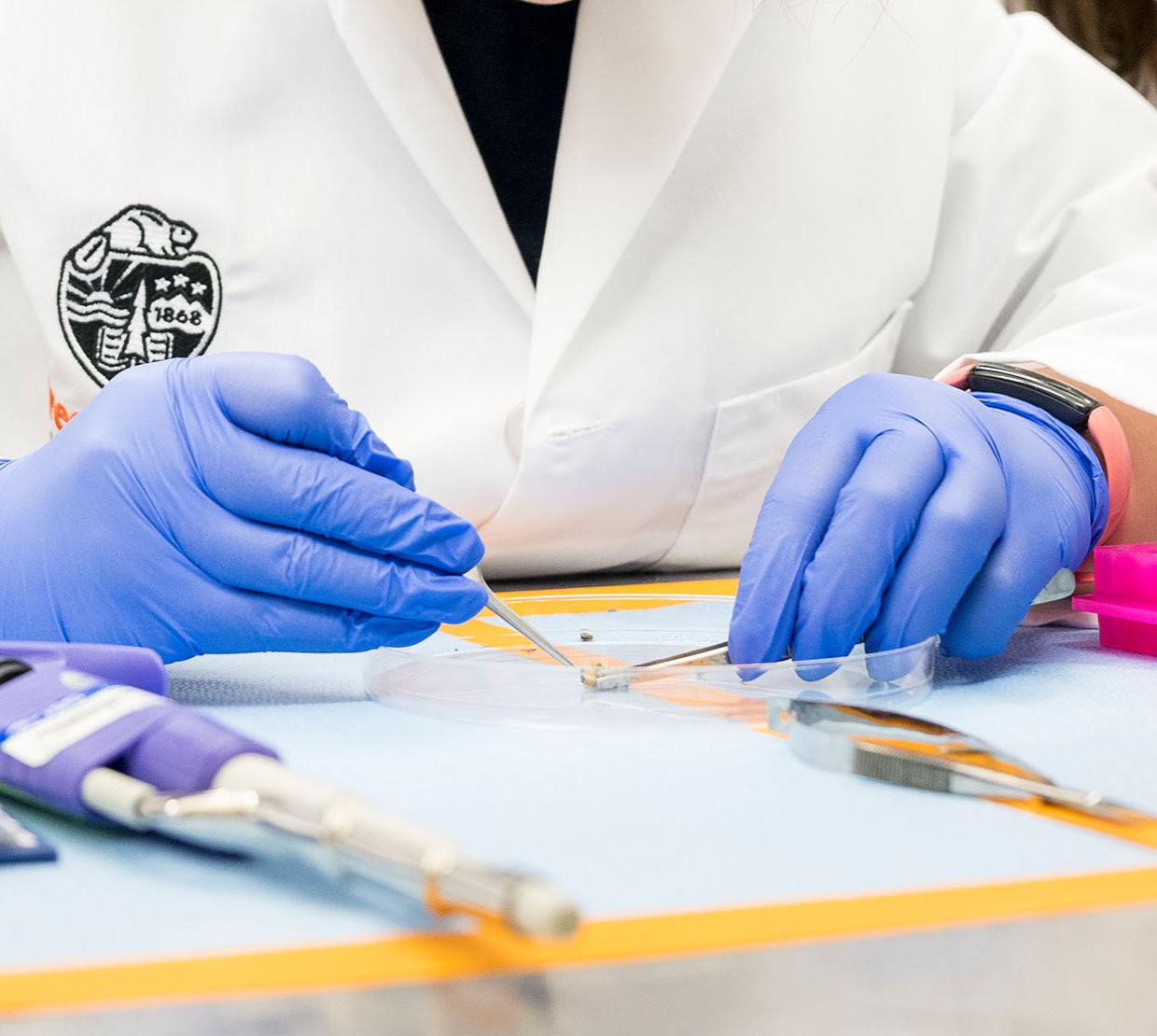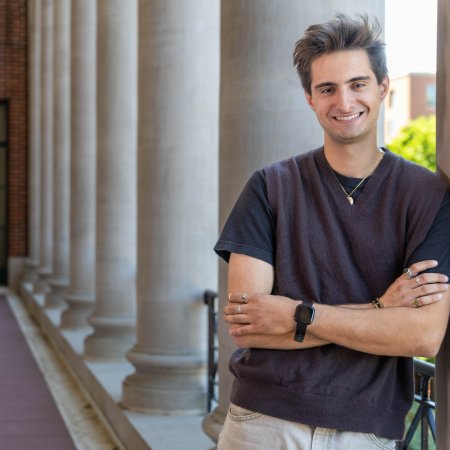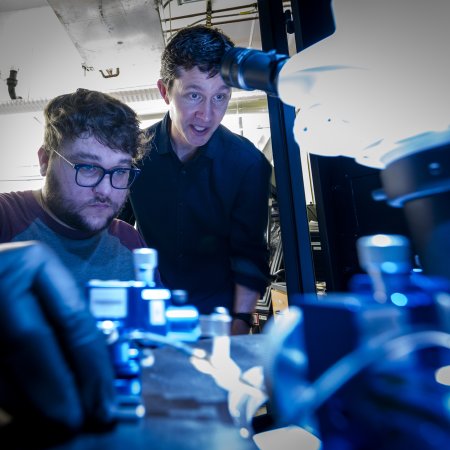Over 11 weeks in 2022, 40 College of Science students worked with faculty mentors to design their own experiments, learn to use new lab equipment, get out in the field and draft papers for publication. In short, they got to be full-time research scientists.
These students did all this through the Summer Undergraduate Research Experience, or SURE Science program, which provides 11 weeks of paid research to College of Science students.
“This scholarship means that I will be able to graduate debt free, work in a place I love and gain experience in my field.”
The many opportunities to participate in research as an undergraduate is what sets Oregon State University apart. Half of the students in the College of Science choose to work in research labs across the university during the school year. The SURE Science program provides the unique opportunity to get paid to participate in full-time research in any lab on campus.
“This scholarship is an opportunity for me to pursue what I am passionate about,” said Caroline Rice, integrative biology major focusing on marine biology. Working with her faculty mentor Sarah Gravem, Cross’ project focused on means of reducing sea urchin populations to help restore kelp forests.
“Ocean conservation has always been something that I am passionate about, so having the opportunity to gain hands-on experience related to a conservation project and to work with the researchers leading the effort has been inspiring. I am very thankful to have the support of this program so that I can gain the experience and skills that will allow me to pursue a career in research.”
“I enjoyed writing my own protocol and conducting my own experiment with little oversight.”
Several SURE Science participants explored topics in new areas of science. Biochemistry and molecular biology major Abigail Pung worked with faculty mentor Ryan Mehl to use genetic code expansion to explore the optimization of protein production. A fusion of synthetic and chemical biology, GCE enables researchers to modify the genetic code of an organism so it can produce designer proteins that have built into them one or a few special building blocks which contain novel chemical groups.
Oregon State has gained a reputation over the last decade as a world leader in improving GCE technologies, and in 2021, received funding from the National Institutes of Health to establish the world’s first genetic code expansion center, called GCE4All. “It is inspiring to be involved in something so new and powerful. It is incredible that people have found a way to unlock the potential of unnatural amino acids and I'm excited to play a part in that.”
Kavi Vaidya, Honors biochemistry and molecular biology major, spent his summer exploring a new technology to help automate mammal cell preparation to allow for more cell sample processing. “The technology I am getting the opportunity to work with has the chance to change the way we study cell-type specific diseases, such as neurodegenerative diseases, and I am excited to get to be a part of its development.”
For other participants, their passion to improve the health and well-being of people and the planet drove their research projects.
"Getting the opportunity to do research that has never been done before and helps to contribute to the search for better treatments is a very exciting and inspiring experience."
Becca Bingham (Honors biochemistry and molecular biology) spent her summer exploring a potential new therapeutic target for Glioblastoma, the most common and deadly type of brain cancer. “Both of my grandmothers died of cancer, and it is such a notorious and frequent killer in today's society,” she said. “Getting the opportunity to do research that has never been done before and helps to contribute to the search for better treatments is a very exciting and inspiring experience.” A transfer student, Bingham chose Oregon State University specifically for the abundant research opportunities available to undergraduate students.
Most of all, the SURE Science program provides students the opportunity to work independently, learn new skills and gain in confidence as scientists.
For integrative biology major Spencer Loring, the entire process of developing his project was a worthwhile experience. “Working with my mentor on the brainstorming of the experiment, writing the proposal, making an experimental procedure, then actually performing data collection and eventually translating it into results and a conclusion. I'm just really excited to have the opportunity to perform my own research project that I will eventually present on and may even get significant results that can be used by fellow scientists in the future.”
Honors microbiology major Aaron Maves also appreciated the independence he was granted in this project. “I enjoyed writing my own protocol and conducting my own experiment with little oversight.”
SURE Science awards are made possible by generous donations from College of Science alumni, faculty and friends. For many students, SURE Science relieves the burden of needing to get a job over the summer. “This scholarship means that I will be able to graduate debt free, work in a place I love and gain experience in my field,” said chemistry major Timothy Walz.
2022 SURE Science Scholars
Ramzy Al-Mulla, Biochemistry and Biophysics
Electrophysiological Characterization of Amygdalae in Osteoarthritic Mice
Mentored by Heidi Kloefkorn
Sullivan Bailey-Darland, Physics
A Dynamic Network Model of Spoken-Word Recognition
Mentored by Kevin Brown
Rebecca Bingham, Biochemistry and Molecular Biology
Investigating the role of nitrated Hsp90 in glioblastoma multiforme migration
Mentored by Maria Franco
Katrina Brown, Chemistry
Identification and Evaluation of highly polar contaminants in surface waters from the Portland Harbor Superfund Site (PHSS)
Mentored by Manuel Garcia-Jaramillo
Evan DuVivier, Biochemistry and Molecular Biology
Role of Cathelicidin Gene Expression in Alzheimer's Development
Mentored by Adrian Gombart
Mathew Frischman, Biochemistry and Molecular Biology
Determining Expression of Neuronal N-Methyl-D-Aspartate Receptor proteins in 5xFAD Alzheimer's Disease Model Mice
Mentored by Kathy Magnusson
Jenna Gaston, Biochemistry and Biophysics
Impact of the Gut-Brain Axis in a Model of Autism Spectrum Disorder
Mentored by Kenton Hokanson
Aleen Golla, BioHealth Sciences
Characterization of phages toward creation of probiotic-like preparations against Johne's disease
Mentored by Lia Danelishvili
Khushi Gupta, BioHealth Sciences
COVID-19 Anti-Viral Drug Design & Optimization
Mentored by Manoj Pastey
Elena Hart, Biology
Phytoplankton abundance and California mussel reproduction
Mentored by Sarah Gravem
Minh Triet Ho, Biochemistry and Molecular Biology
Phylogenetic analysis of Bodhi tree samples from biodiversity network iNaturalist
Mentored by Dee Denver
Johan Huurman, Physics
Electronegativity of organic molecules
Mentored by (Paul) Ha-Yeon Cheong
Kaitlyn Kim, Biochemistry Biophysics
Early changes in physiology, activit, and memory of 5xFAD mice using non-invasive cage technology
Mentored by Kathy Magnusson
Finn Lawless, Biochemistry and Molecular Biology
The role of antiactivators in quorum sensing of pathogenic bacteria Pseudomonas aeruginosa
Mentored by Martin Schuster
Michelle Le, BioHealth Sciences
Can alternative methods of pasteurization of donor milk improve lipid absorption and growth in preterm infants compared with Holder pasteurization?
Mentored by David Dallas
Auria Lee, Biochemistry and Molecular Biology
Impact of novel pseudo-sugar on secondary metabolite production
Mentored by Taifo Mahmud
Jacob Lessard, Chemistry
Deuteration of drug molecules using metal-organic framework photocatalysts
Mentored by Kyriakos Stylianou
Spencer Loring, Biology
Identification of calanus species through genetic testing
Mentored by Felipe Barreto
Aaron Maves, Biology
Potential benefits of phage-driven immune responses against Mycobacterium abscessus infection
Mentored by Lia Danelishvili
Ebunoluwa Morakinyo, Biochemistry and Molecular Biology
Analyzing the role of gene expression regulator CTIP1 and vitamin D signaling on skin wound healing
Mentored by Gitali Indra
Matthew Nguyen, Chemistry
Water harvesting using a metal-organic framework possessing open metal sites
Mentored by Kyriakos Stylianou
Julia Pavlosek, BioHealth Sciences
Effectiveness and scalability of a home health navigator program to reduce environmental hazards
Mentored by Veronica Irvin
Annalee Pelayo-Ortega, Biochemistry and Molecular Biology
Improving gene targeting by gene deletion of double-stranded DNA repair
Mentored by Michael Freitag
Abigail Pung, Biochemistry and Molecular Biology
Tetrazine-linked protein optimization via Tet-MbRS enzyme alteration
Mentored by Ryan Mehl
Lydia Pung, Biochemistry and Molecular Biology
Structure and assembly of YAP regulatory complex in hippo signaling
Mentored by Afua Nyarko
Rachel Pung, Biochemistry and Molecular Biology
Exploring the benefits of alternative pasteurization techniques to maintain bioactive proteins for premature infants’ health
Mentored by David Dallas
Rebekka Purcell, Biochemistry Biophysics
Exploration of electrophysiological properties of immortalized hypothalamic kisspeptin neurons in vitro
Mentored by Patrick Chappell
Caroline Rice, Biology
Restoring kelp forests via experimental urchin culling methods
Mentored by Sarah Gravem
Ai Ana Richmond, Zoology
The impact of inclement weather on the foraging behavior of red crossbills (Loxia curvirostra)
Mentored by Jaime Cornelius
Jake Roetcisoender, Biochemistry and Molecular Biology
PCR-based sequencing of Chlamydia trachomatis strains using non-viable clinical samples
Mentored by Daniel Rockey
Brenna Rothman, Biology
Evaluating the return of Pycnopodia helianthoides in Holmes Harbor, Washington to inform species recovery strategies
Mentored by Sarah Gravem
Alexis Schwartz, Biochemistry and Biophysics
Studying the electrophysiology of malignant U87 glioblastoma cancer cells
Mentored by Kenton Hokanson
Gabriella Sewell, Biology
Effects of stream intermittency on macroinvertebrates and steelhead (Oncorhynchus mykiss) in central Oregon
Mentored by Matt Orr
Kavi Vaidya, Biochemistry and Molecular Biology
Qualitative and quantitative comparison of mass spectrometry-based proteomic profiles of samples generated by manual and automated bulk cell dispensing
Mentored by Claudia Maier
Anusha Vasudevan, BioHealth Sciences
Investigating the interplay of aging, zinc status, and the gut microbiome on gut health
Mentored by Emily Ho
Timothy Walz, Chemistry
Hydrogen sulfide adsorption in amino-functionalized metal-organic frameworks
Mentored by Kyriakos Stylianou
Michelle Wambui, Biochemistry and Molecular Biology
Understanding the mechanisms of phage-mycobacteria interaction
Mentored by Lia Danelishvili
Jasmine Weaver, Biology
Measuring allele proportion in hybrid cross of Tigriopus californicus after heat stress exposure
Mentored by Felipe Barreto
Alice Welch, Biology
Development of foraging behavior in red crossbills
Mentored by Jamie Cornelius
Owen Williamson, Physics
Engineering a kinesin-14 motor protein
Mentored by Weihong Qiu



